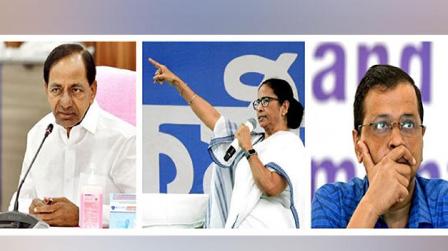Let’s count girls…

Nivedita Patnaik
Every year on January 24 we celebrate Girl Child Day. This year, on the occasion of Girl Child Day, an alarming situation in the state came before everyone. The number of girls is decreasing compared to boys in the state. The situation is particularly alarming in 6 districts. They are Nayagarh, Dhenkanal, Subarnapur, Angul, Jagatsinghpur and Kendrapara. In these districts there are 811, 852, 880, 885, 897 and 898 girls respectively compared to 1000 boys. This is a matter of concern.
According to the data of the National Family Health Survey-5 conducted in 2020-21, the number of girls is decreasing rapidly in Odisha. According to National Family Health Survey-5, the number of women per 1,000 men in Odisha was 894, and according to NHS-4, the number of women per 1,000 men was 932. That is, the number of girls in the state is decreasing rapidly, which is a statistical proof of increasing gender inequality. In 2001, the number of women per 1,000 men was 953 and in 2011, it was 941. In the last ten years, the number of women has decreased by 4.7%. So where did the girls go?
Why girls are missing:-
Discrimination between boys and girls is ingrained in the human mind. Many birth mothers also think that a girl child is a burden on the family. Even being a woman herself, she is interested in sons, as a result of which the proportion of women in the world is decreasing.
After so many years of independence, a crime like the murder of young women has been ignored. Girls have been neglected in every sphere of society. In today’s society, a girl child faces various problems and challenges. Discrimination between girls and boys, predominance of boys, domestic gender violence, sexual abuse, child marriage, sexism, deprivation of education and health, lack of opportunities in the workplace, gender selection and destruction of female children, low social status in society, etc. .
Pre-natal sex-assignment and destruction of female fetuses are practiced every day in India. Due to this, the number of women is decreasing compared to men.
Currently, while the national average is 943 females per 1,000 males, it is a matter of concern that the number of girls aged 0-6 years is 927 per 1,000 boys in 2001, while it has decreased to 919 in 2011. Its primary reason is that women are undervalued in Indian society
Because As a result, many Indian families do not want to give birth to a girl child or raise a girl child properly.
Many schemes and laws have been implemented in our country or state for the protection and interest of the girl child. The Government of India enacted the Pre-Natal Diagnostics (Regulation and Prevention of Misuse) PND Act in 1994 to address the problem of declining girl child ratio. It was amended in 2002 and renamed as the Pre-Consent Pre-Natal Diagnostic Techniques (Prohibition of Sex Selection) PCPNDT Act. All Ultrasound and Sonagraphy clinics will be registered under this Act and it will be considered a non-violableoffense if gender identification is carried out here. For which imprisonment and fine will be imposed.
Unfortunately, the implementation of this law is very poor. Gender relegating institutions cannot be successfully punished.
Prenatal gender identification is widely practiced in our society as the expectation of having a boy rather than a girl is high
The process is one of the main causes of low child birth rates. By misuse of technology
A girl child is lost in darkness before giving birth. According to international human rights standards, every child has the right to be born free. Abortion after sex-signaling and identification is becoming possible due to the widespread use of scientific technology.
Broadly the Art of 1994 had the following provisions:
(a)Regulation and Genetic Counseling Centers, Genetic Laboratories and
(b) Genetic Clinics (Section 3);
(c)Regulation of Pre-natal Diagnostic Techniques (Section 4 to 6);
(d) Constitution of Central Supervisory Board (Section 8 to 10);
(e) Appointment of Appropriate Authority and Advisory Committee (Section 17);
(f) Registration of genetic counseling, genetic laboratories & genetic clinics (Sec 18-21);
(g) Offences and penalties (Section 22 to 28).
Based on the Supreme Court order and in order to curb the emerging trend of sex selection as well as sex determination and Consequential abortion the parliament made necessary amendments to the Act of 1994 and tightened the legislation for preventing sex selection and female feticide. The Parliament replaced the Act 1994 with a new Act titled pre-conception and pre-Natal Diagnostic Technique (Prohibition of sex selection)Act bringing preconception formula under the purview of the Act.
The objectives of the new Act of 2002 are:
(a) To ban the pre-conception sex selection techniques.
(b) To prohibit the misuse of pre-natal diagnostic techniques for sex selective abortions,
(c) To regulate the pre-natal diagnostic techniques for the appropriate scientific use for which they are intended, and
d) To ensure the effective implementation of the Act at all levels
1. It made it obligatory that the Prenatal Diagnostic Techniques can be used in the following conditions (Section 4-3)
• Age of the pregnant woman is above 35 years,
• The pregnant woman has undergone two or more spontaneous, abortions or factual loss;
• The pregnant woman had been exposed to potentially teratogenic agents such as drugs, radiation, infection at chemicals,
• The pregnant woman has a family history of mental retardation or physical deformities such as spasticity or any other genetic disease.
2. The Act prohibits the use of modem technologies like amniocentesis and sonography for sex selection before the conception. Some important features of the new Act are:
• It prohibits the sex selection on a woman, man or on both or on any tissue, embryo concept us , fluid or gametes derived from either or both of them by a specialist or a team of specialists. In the field of infertility (Section 3-A).
• It prohibits on sale of ultrasound machine, imaging machine or scanner or any other equipment capable of detecting sex of the focus etc. to persons, laboratories, clinics, etc. (Section 3-B)
3. It mandates compulsory Registration of all Diagnostic Laboratories. The manufacturers of ultrasound equipment would now be required to sell their products only to those clinics that are registered (Section-8)
4. All the Genetic Counseling Centers, Genetic Laboratories, Genetic Clinics and Ultrasound Clinics irrespective of whatever they are involved in as regards diagnosis for gynecological or other purposes, would now have to maintain records of all the tests conducted by them (Section 29)
5. It says that no person can communicate to the pregnant women connected or her relatives or any other person the sex of the focus by words, signs, or in any other manner while conducting prenatal diagnostic procedures (Section-5z)
The important provision of the new Act is that the fine for those who indulge in sex
determination procedure has been doubled from Rs.50.000/- to Rs 5,00,000/-with additional provision for the suspension and cancellation of the registration of those who violate the law.
The pre-natal Sex determination techniques were developed with an immensely important purpose of detecting genetic or metabolite disorders or chromosomal abnormalities or certain congenital malformation or sex linked disorders. However with the help of the medicate community people started using it for fulfilling their desire to have a baby boy. In the name of medical test to identify the disorder it is being used to determine the sex of the factors, which often lead to sex selective abortion. The technique has a great role in the life of a person from the health point of view. where as its use is dubious. Such technology has become an aid to perpetuate discrimination against women in the most planned manner. Good means are not used for good ends.
Sex selective abortion Sex selections at the time of conception are both moral turpitude and crime against humanity for this needs to be recitative at all cost. Gender selection and determination need to be condemned, because they transgress the law and violate the fundamental human rights of woman as a class
to be born and to be embrace life. In fact it is a fundamental duty of every citizen of our of our country to up hold the dignity of women. Elimination of free birth of females is against the life and dignity of woman. Nevertheless it is also a grass discriminatory practice on the basis of sex.
If the child sex ratio persists for a long time, it will have an unfortunate effect on the country’s population balance. This creates an alarming situation for the society.
In this context, there is a need to establish a national monitoring cell to sensitize the local authorities, medical teams and review the implementation of the PCPD Act. Apart from this, civil society and family should pay attention to find the root cause of why women are undervalued in the society.
Civil society has an important role to play in this problem. There is a need to create more awareness about gender balance in the society.






